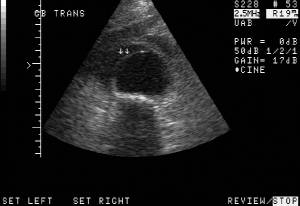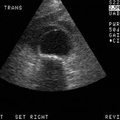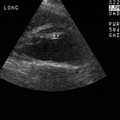
RADIOLOGY: HEPATOBILIARY: Case# 100: CHOLECYSTITIS (CT&US). Right abdominal pain with abnormal sonogram of the gallbladder. There is a layering density present in the gallbladder with apparent discontinuation in the gallbladder wall. Pericholecystic fluid is present with free intraperitoneal fluid around the liver also. No air is present in the gallbladder. Wispy infiltrative changes are present in the adjacent intraperitoneal fat consistent with inflammation. Acute cholecystitis, or inflammation of the gallbladder, can be classified as calculous (associated with gallstones) or acalculous. Gangrenous cholecystitis is a rare form of acute cholecystitis which is often indistinguishable from acute cholecystitis. The mortality rate of gangrenous cholecystitis is 22% while the mortality rate for acute cholecystitis is only around 1 to 6%. Symptoms associated with the onset of acute cholecystitis include progressive right upper quadrant or epigastric pain, mild fever, anorexia, tachycardia, diaphoresis, and nausea and vomiting. Lab abnormalities associated with this condition include mild to moderate leukocytosis often accompanied by mild elevations in serum alkaline phosphatase values. Most cases of acute cholecystitis are diagnosed clinically, via ultrasound, or via radionuclide hepatobiliary scan. CT is used to evaluate complicated or atypical cases. CT findings include gallstones (in 95% of patients), distended gallbladder lumen (greater than 5cm), thickening of the gallbladder wall (greater than 3mm), halo of subserosal edema in the gallbladder wall, pericholecystic fluid collection associated with perforation, increase in bile density (20 H) (due to biliary stasis, intraluminal pus, hemorrhage. or cellular debris), and air in the gallbladder wall (emphysematous cholcystitis).
- Author
- Peter Anderson
- Posted on
- Thursday 1 August 2013
- Tags
- hepatobiliary, radiology
- Albums
- Visits
- 2589


0 comments